Aug 30, 2020 | ancient, coins, news, shows
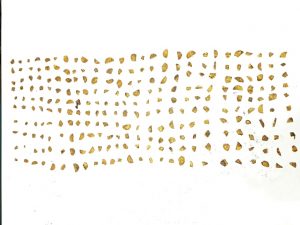
Hoard of 9th Century Gold Dinars found during an excavation in Israel (Credit: Robert Kool/Israel Antiquities Authority via CNN)
The jar of coins found consists of 425 24-karat gold coins weighing 845 grams (1.86 pounds). Most of the coins are cut to that were once used as change.
The Israel Antiquities Authority (IAA) says that the area was under the rule of the Abbasid Caliphate. Their rule spread from modern-day Algeria in the east to Afghanistan in the west from 750–953 when Shia opponents overthrow the caliphate. There were many successors to the Abbasid Caliphate. They joined together in 1157 to create a cooperative empire that was eventually overthrown by 1258 by Mongol forces.
Finding a hoard of gold coins and the surrounding artifacts will help archeologists learn more about the region’s commerce. Once again, numismatics helps scientists better understand our history.
The following video from the IAA talks about the project and finding the coins.
The other news is the conclusion of what was a successful Newman Numismatic Portal Symposium 2020. The symposium, held online using Zoom, had several interesting speakers and presentations. Although NNP has yet to publish its final statistics, the sessions I attended were well done and seemed to be well attended.
My session, “How to Identify a Potential Scammer BEFORE Buying Coins Online,” was attended by more than 60 people and generated about a dozen questions. It was a great experience.
I will have more to say about the NNP Symposium in the next few days.
And now the news…

August 24, 2020
Two Israeli teenagers on summer break unearthed a trove of hundreds of gold coins that date from 1,100 years ago.

→ Read more at
edition.cnn.com

August 26, 2020
Are you looking for ways to tell if your silver is authentic?—the “real McCoy”? There are several ways you can determine whether your silver is real. In fact, some of the best silver test methods are quite easy and can be done right at home.

→ Read more at
gainesvillecoins.com

August 28, 2020
On October 15, 1794, Henry Voigt, the Chief Coiner of the United States, hurried nearly 2,000 silver coins to the desk of David Rittenhouse, the Director of the United States Mint. That day marked a milestone in the making of a country: Two years after Alexander Hamilton established the Mint under President George Washington, the first dollars had been minted.

→ Read more at
atlasobscura.com

August 28, 2020
Oleksandr Alfyorov / Facebook

→ Read more at
unian.info

August 28, 2020
Somebody stole a very pricey potty last year from the restroom of a palace in England. But the police still don’t know who did it and have been trying to find out ever since. “The toilet is still missing,” a Thames Valley Police spokesman confirmed to USA TODAY Aug.

→ Read more at
usatoday.com
If you like what you read, share, and show your support 
Jul 12, 2020 | ancient, coins, policy
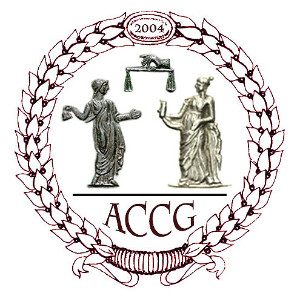 Once again, the State Department is about to do something that negatively affects a part of numismatics. Even if you are not an ancient coin collector, the ability to collect and study ancient coins helps give all of us clarity into history.
Once again, the State Department is about to do something that negatively affects a part of numismatics. Even if you are not an ancient coin collector, the ability to collect and study ancient coins helps give all of us clarity into history.
If the State Department permits the Memorandum of Understanding with Italy to pass, it will signal an end to ancient collectors’ ability to participate in the hobby. First, it will be the restriction of ancient Roman coins, then others will follow. Soon, every coin will become cultural property and locked in a museum, never to be seen again.
I heard it explained that coins were never meant to be static items. The rulers of ancient lands intended for the coins to circulate with their image. It was supposed to tie people to the empire. It was so important to pay the soldiers and circulate the money that coiners accompanied many armies. They would strike coins using the looted material and move on to the next conquest.
Most of these coins are not rare or even scarce. They are common, often seeing hoards of hundreds and accumulation of thousands across Europe. Some of the scarce coins can be readily found on the market and in museums.
However, if we listened to the archeologist, every crumb they find from the ancient past belongs in a museum. The necessity to save every widow’s mite is like wanting to save the Cross of Coronado.
From Wayne Sayles, Executive Director of the Ancient Coin Collectors Guild:
ACCG needs your help in defending collector rights under the law – Please comment now! It’s fast and easier than ever. No need for elaborate arguments or research, others have already taken care of that. What we need now is to demonstrate that import restrictions on ancient coins affect a lot of caring people and law-abiding people from all walks of life and all political persuasions.
The deadline to send a comment to the Cultural Property Advisory Committee (CPAC) has been extended to July 14, 2020. Comments can be left at:
If you want more detailed information and a sample letter to the CPAC, read:
In fact, read it anyway. It contains a lot of useful information.
We should stand up for the hobby, whether you collect ancient coins or not!
May 16, 2020 | ancient, coins, museum
Continuing the Museum Week celebration, there was an announcement from another numismatic exhibit added to the online world. The Walsh Library of Seton Hall University announced the addition the D’Argenio Collection. The collection consists of 427 rare coins from ancient Greece, the Roman Republic, the Roman Empire, and Byzantium.
Donated to the university by Ronald D’Argenio (MS’76/JD’79), the collection allows scholars “to trace the relationship of the earliest Roman coins of the Republican period to its immediate Greek predecessors. It includes coins with images of Julius Caesar, the first Roman leader to have his portrait represented on a piece of currency.”
The library added the collections to the Google Arts and Culture online collection. “Google Arts and Culture is a rapidly growing site that displays highlights from over 2,000 museums and private collections. Its app, which can be downloaded from Google Play or the Apple Store, allows the visitor to interact with the artwork through AI features like virtual tours and exhibits.”
The online exhibit is in two parts:
Jan 20, 2020 | ancient, coins, legal, news
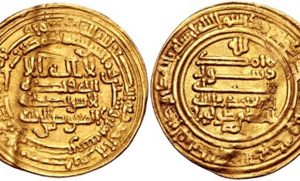
Abbasid coins of the late ninth century
(via Egypt Today)
The Ottoman Empire was the last of the significant conquering empires of Europe. By the late 19th century, modernization and uprisings forced the Empire to consolidate around the area of modern-day Turkey and the Middle East. Even though the Empire was declining, that did not stop the government from trying to exert influence.
After Great Britain left Egypt in 1914, the Ottomans stepped in and demanded Egypt pay tribute in the form of gold coin to the Empire. After the fall of the Empire and the formation of modern-day Turkey, they continued to demand tribute. Egypt stopped paying the tribute on the establishment of the Republic in 1953.
The lawsuit claims that the Ottomans and Turkey illegally removed the coins from Egypt and demands their return.
In one report, the brief cites the provisions of the UNESCO convention as authority for demanding their return by declaring the coins as cultural property.
If allowed through their courts and if the suit is successful, it becomes precedent for Egypt to claim any item as cultural property and demand their return. Aside from coins, exhibits at museums around the world would have to prepare for similar requests. In the United States, the Brooklyn Museum has one of the most extensive Egyptology collection in North America. Their holding is second to the British Museum, who will also face the same questions.
Ancient Egypt did not have a monetary system as we know it today. Since they did not have silver mines and gold was scarce, they traded goods and services. Taxes were paid by people providing products or working for the government.
There are known bronze coins from early periods, but several references noted that they were used for a limited amount of trade.
The first known coins of Egypt came during the Ptolemaic Empire of ancient Greece. By that time, the Egyptian Empire moved up the Nile River from the area near modern Cairo to modern-day Alexandria. As a weakened Empire, Ptolemy I was able to conquer these areas of the Middle East following the death of Alexander the Great.
It was a time of great fortune that included education, the arts, and modernization of the old Egyptian Empire. Silver and gold were brought as the economy soared. Ptolemaic coins are considered Greek coins for many collectors of ancient coinage.
Those who enjoy collection ancient coins should carefully watch this case as it winds through the Egyptian courts. The wrong outcome will affect collectors and be another attack on the hobby.
And now the news…

January 13, 2020
…My Proustian moment came when I read Maurer’s comment: “People working on new technologies of money tend to assume that money is just money…

→ Read more at
frbatlanta.org

January 15, 2020
14 January 2020 Almost 1,000 coins dating back to the years 1500 – 1600 have been discovered in the locality of Săbieşti, in Dâmboviţa county, some 50 km north of Bucharest.

→ Read more at
romania-insider.com

January 15, 2020
It looked, on first examination, like an antique charm bracelet loaded with gold trinkets: a tiny Eiffel Tower and a little bowling pin and iconic images of provincial Italy. The owner thought the family heirloom might fetch $8,000 on the open market.

→ Read more at
ottawacitizen.com

January 16, 2020
While first responders in Windsor-Essex save other peoples' lives every day, they're now equipped with a new 'All In Coin' taking aim at their own mental health. Essex-Windsor EMS and Essex Fire are giving out coins to their workers to make it easier for them to talk when needing mental help.

→ Read more at
cbc.ca

January 18, 2020
A rare coin featuring Britain's King Edward VIII, who abdicated to marry American divorcee Wallis Simpson, has sold for a record £1 million

→ Read more at
cnn.com

January 18, 2020
CAIRO – 18 January 2020: Egypt’s Administrative Court has set February 15, 2020 to consider a lawsuit demanding Turkey to repay Egypt more than 23.1 million gold coins that were taken from Egypt in tribute by Ottoman Empire “illegally.”

→ Read more at
egypttoday.com

January 19, 2020
If you’re keen to own a piece of British history, The Royal Mint January sale may have just what you’re looking for.

→ Read more at
dailyrecord.co.uk
Jan 6, 2020 | ancient, coins, news
I have been a busy week, month, and year. Many of you have stuck with me while Real Life has taken a lot of my time. I appreciate your support. I have more things to write about and will try to do so in 2020.
Resolve to keep happy, and your joy and you shall form an invincible host against difficulties.
— Hellen Keller
News opened for the new year with ancient coins returning to Mexico after previously been legal for trade.
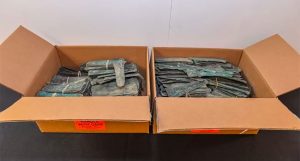
Pre-Hispanic Mexican coins that were recently “returned” to Mexico (Image courtesy of Mexico News Daily)
After the coins were taken to Spain for auction, the Mexican government contacted the FBI asking for their help. Allegedly, the collector voluntarily turned them over.
Even though the coins were obtained legally and subsequently legislated into chattel, foreign governments continue to attack United States collectors because they can.
Under the UNESCO convention, numismatic items are the most problematic. When so many examples exist, every coin should not be considered cultural property. Countries can be reasonable and hold back a few examples that would help tell their story, but what is wrong with sharing that story with the world? Does 3,500 coins, most that will never see the light of day again, have to be hidden from the public in Mexico? Would it be against Mexico’s interest to share about 85-percent of that hoard with the world?
Watchers of how countries selectively enforce the provisions UNESCO convention will note that the majority of claims on the alleged numismatic cultural property occurs in the United States or against Americans abroad. Why does the Italian government not claim property rights for all the Roman hoards found in the United Kingdom? Why has there not been claims made against hoards found along the path of the Silk Road during the last few decades?
The only time the UNESCO convention is invoked for numismatics is when someone tries to smuggle coins out their countries, which is reasonable, or in the United States. Why?
And now the news…

December 31, 2019
The United States returned a collection of over 3,500 pre-Hispanic copper coins to Mexican authorities in a ceremony in Miami on Monday. The coins were used in what are now Michoacán and Guerrero between the years 1200 and 1500, according to Jessica Cascante, spokesperson for the Mexican Consulate in Miami.

→ Read more at
mexiconewsdaily.com

December 31, 2019
What I see for them is not yet, What I behold will not be soon: A star rises from Yaakov, A scepter comes forth from Yisrael; It smashes the brow of Moab, The foundation of all children of Shet. Numbers 24:17 (The Israel Bible™)

→ Read more at
breakingisraelnews.com

January 1, 2020
Rare gold dinars from Abbasid caliphate period found inside a juglet in Yavneh Liat Nadav-Ziv, Israel Antiquities Authority A hoard including rare gold coins from the early Islamic period about 1,200 years ago was found during a salvage excavation in Yavneh on Thursday.

→ Read more at
haaretz.com

January 5, 2020
To take one and two-cent coins from circulation, such is the idea the Bank of Lithuania will start a discussion on. Retailers, however, see risks in consumer mood over rounding sums up.

→ Read more at
bnn-news.com

January 5, 2020
Today when authorities warn of bad bills or counterfeit money it's usually 20 dollar bills. In 1908 the problem was bogus coins — silver dollars, dimes and quarters. While it might seem not worth the trouble to create, such a coin could purchase much more than today.

→ Read more at
whig.com
Nov 28, 2018 | ancient, coins, commentary, foreign, legal, policy
I said that if we do not act that we would become victims!
A man came into my shop the other day. Like all new visitors, my assistant greeted him with her usual charm while he looked at the eclectic inventory in the showroom.
The man was different than others. On a slow morning, he lingered around the set of auction catalogs I have for sale while saying little to my assistant who felt uncomfortable with this man in the shop. Another customer came into the shop and my assistant took care of them while I watched this gentleman.
After a while, he came to me and, in a heavy accent I could not identify, asked if I was the store’s owner. He pulled out a few folded pieces of paper and showed me a sheet with the article “Coin jewelry is not legal everywhere” I wrote on this blog in April 2016.
He pointed to one of the pictures and asked if I knew anything about the coin. I asked why and he said he was interested in purchasing one. For some reason, I had a feeling that he might have had other interests in mind.
-
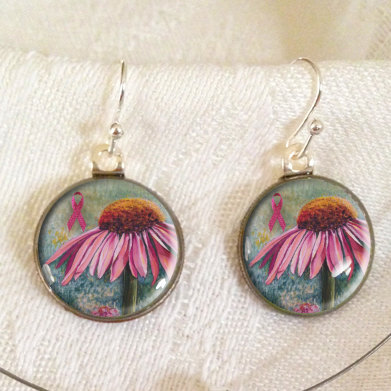
-
Resin ear rings made by InspiringFlowers using Roosevelt dimes
-

-
Hummingbird cut from a Trinidad and Tobago penny by SawArtist
-

-
1996 Half Dollar Ring by LuckyLiberty
Examples of the coin jewelry from the orignal post
I explained to that I do not carry a lot of jewelry since it is not a specialty of my business. When I do have jewelry in stock it does not sell well. He opened the paper and asked if I knew anything about the jewelry on the page.
I explained that the article he is holding is from a blog post I made explaining how some countries have restrictions regarding the usage of their coins for jewelry. When he pressed for more information I said that it was noted in the posting that the images came from Etsy and I do not know any of the sellers. Their goods were used as an example for the posting.
It felt like I was being interrogated. I asked if he was a member of law enforcement or any other government investigative agency, he mumbled something I did not like. I asked him to leave. My assistant had called the police.
The police arrived and escorted the man out of the shop and questioned him before letting him drive away in his own vehicle. I noted the license plate. The officer came inside and said that this will be handled elsewhere and that I was not to report it any further.
About a week later, I was visited by someone representing a federal agency and a member of federal law enforcement who wanted to question me about the incident. After they produced proper identification, we went into my office to discuss the matter.
I was told that the man who came into my shop was an agent for an unnamed foreign government. This government has been visiting collectible stores and shows to intimidate people into “returning cultural items” from that country. The country that this person represents considers this legal even though it violates my Fifth Amendment right of due process.
Apparently, the person that visited my shop is responsible for the “confiscation” of items from more than a dozen antiques and collectibles shops in the mid-Atlantic region.
It is not the first time we have heard the foreign governments have tried to go around the United States’ right of due process by trying to confiscate coins under the guise that they are “national treasures.” In 2013, I wrote “Why you should care about restrictions on collecting ancient coins” sounding an alarm for people to act.
People did not act or act strongly enough. It has allowed a foreign government to pervert the 1970 UNESCO Convention’s intent to steal legally obtained inventory from United States businesses they claim are national treasures.
In the next few weeks, I will be writing a short position paper to present to the American Numismatic Association in order to get them to work to protect collectors. It is time that the ANA and other numismatic organizations work together to protect the hobby and stop kowtowing to every country who wants to retroactively make a claim against United States business because a foreign government said so.
Aug 27, 2017 | ancient, coins, commentary
 This week, the BBC reported about Toby Robyns, a 52-year-old ambulance driver from the U.K., who may be facing an up to three-year prison sentence for trying to take home ancient coins he found on a beach in Turkey.
This week, the BBC reported about Toby Robyns, a 52-year-old ambulance driver from the U.K., who may be facing an up to three-year prison sentence for trying to take home ancient coins he found on a beach in Turkey.
Immediately, my thoughts turned to a story I wrote about my friends in a similar situation. While sitting on a beach, they found several ancient coins. Just like the British man, they threw their finds in their luggage and proceeded with their vacation.
When airport security found the coins in the luggage they detained Robyns, just like what happened to my friends.
One of the differences between the two stories is that the U.K. news outlets are reporting about this state sanctioned abduction. It was confirmed that when the family that returned to the U.K. they contacted the media to tell the story.
In the U.S., my friend’s family was asked by the government representatives not to talk about the case with the media. Part of the reason was that my friend was working for the U.S. federal government at the time and had clearances. Although it cannot be confirmed, I am sure that this is why his story ended quickly.
Regardless of the disposition of Mr. Robyns’ case, the damage has been done. The coins are likely not valuable and this is nothing more than harassing a foreign national because they can. And given some of the rhetoric between Turkey, Europe, and the U.K., especially over Brexit and the Middle East refugee situation, it will be unfortunate if Mr. Robyns is made to pay for the politics.
And now the news…
August 21, 2017
Priceless collection of 75 gold Roman coins depicts evolution of propaganda and portraiture over 300 years → Read more at timesofisrael.com
August 21, 2017
The Treasury Department will accept orders for special coins commemorating King Rama IX’s cremation at banks and state financial institutions from Aug 22 to Sept 30. → Read more at bangkokpost.com
August 22, 2017
"We don’t give away keys to the city, John. Too many people breaking in." → Read more at denverite.com
August 23, 2017
It's a challenge coins for veterans to be given out by police officers → Read more at wbay.com
August 23, 2017
The pair had been sweeping a recently ploughed field with metal detectors when they discovered the buried hoard → Read more at cornwalllive.com
August 23, 2017
A Government push to phase out the old pound coin is being hampered by firms mistakenly returning its 12-sided replacement. Around half of the coins being delivered to cash centres have turned out to be the new pound coin, slowing efforts to remove the round pound from circulation. → Read more at helensburghadvertiser.co.uk
August 24, 2017
Ambulance driver Toby Robyns was arrested as he prepared to fly home with his family. → Read more at bbc.com
August 24, 2017
The Cairo International Airport antiques’ unit blocked an attempt by an Egyptian passenger to smuggle a collection of Khedival-era coins, paper currency, contracts, and bonds to Saudi Arabia on Wednesday, the unit head said in a statement. → Read more at egyptindependent.com
August 26, 2017
(JTA) — An 8-year-old Israeli girl found a rare coin from the Second Temple period. The half-shekel coin dates from a time when it was used to pay a yearly Temple tax, archaeologist Zachi Dvira told The Times of Israel. The custom is prescribed in the Torah (Exodus 30:11-16). Hallel Halevy discovered the coin in… → Read more at jta.org
Aug 21, 2017 | ancient, coins, commentary, foreign
As we wait for the shadow of the moon to trek across the United States from Oregon to South Carolina, I was curious as to whether there were coins ever created to commemorate any of the past eclipses regardless of location.
Allowing an online search engine to help, I was able to find a few coins.
-

-
1999 Alderny Total Eclipse of the Sun Commemorative Five Pound Coin
-
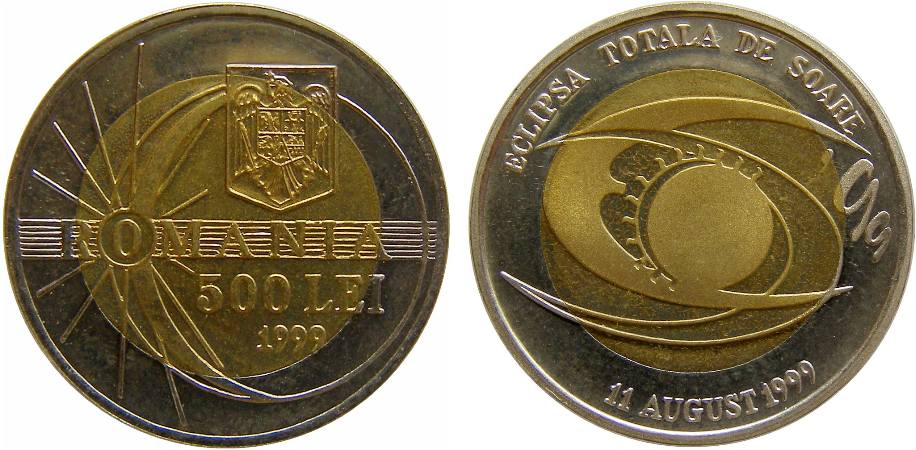
-
1999 Romanian Eclipse 500 lei bi-metalic commemorative coin
-
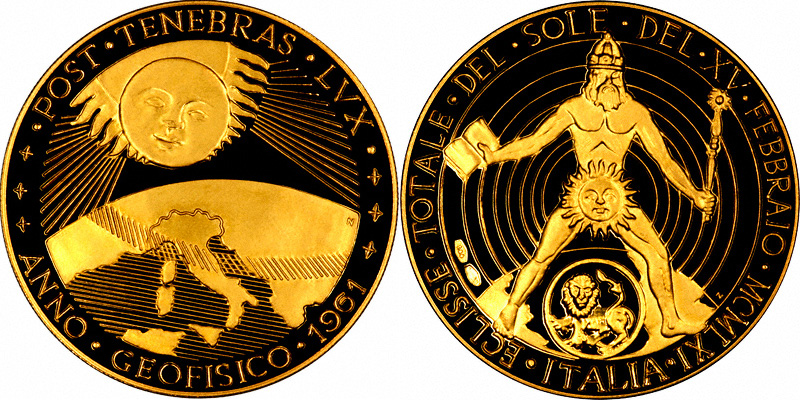
-
1961 Italy Total Eclipse of the Sun Gold Medallion (Image courtesy of Chard)
-

-
Minting of these coins in Nikopolis could indicate an eclipse focused on that region
I am sure there may be a few more, but I need to run out to pick up a pair of those funky glasses!
Jun 8, 2017 | advice, ancient, coins, news, video

Amateur photos of stolen coins — like this, taken from a cache of images held by a middleman — are sent from phone to phone in the underground trade.
A Wall Street Journal report said that Swiss authorities have been investigating Ali and Hicham Aboutaam, owners of the Phoenix Ancient Art Company with offices in New York and Geneva. It is alleged that items that they have been trading in artifacts looted by ISIS.
In one famous video, ISIS militants were shown destroying artifacts with the voice-over declaring, “These idols and pagans for people in the past centuries were worshiped instead of Allah. When Allah ordered to destroy and remove them, it was an easy matter. We don’t care, even if it costs billions of dollars.”
That may have been a ruse by only showing a few items destroyed since it is estimated that ISIS generates $100-250 million per year selling looted antiquities on the black market.
While art and statues are easy to trace, coins are a different story. Coins can be carried easily in pockets, wrapped in clothes, or just “innocently” thrown into luggage and smuggled anywhere in the world. Detection is difficult and without documentation, they may be difficult to trace.
Reports in the international media note that weak laws and the lure of significant profits have kept the sales of artifacts and looted coins moving through the system. Looted coins have been sold on sites like eBay and Etsy without fear of reprisals because their provenance cannot be proven.
Even though the 1970 UNESCO Convention was agreed upon to stop archaeological pillaging and trafficking of cultural property, the way it is implemented in most countries is to recover the item at its final destination and not in transit. An unsuspecting collector or dealer could be in the position of one of these looted coins but have to face the consequences if they are caught.
The sale of these coins supports ISIS and their terrorist activities. Even after the coins have changed hands several times, they could circulate through the industry and be used by dealers down the like who will continue to trade the coins and using the profits to help fund ISIS.
It would be easy to say to resist buying ancient Syrian or Persian coins, but there are coins that were not stolen and can be legitimately owned. This might be an area that the Ancient Coin Collectors Guild should weigh in on behalf their community.
Until then, try to limit your purchases to reputable dealers and dealers you know.
Wall Street Journal Video
Nov 30, 2016 | ancient, coins, museum, news
While growing up in the New York City area, my mother felt that her children should go out and see the area which we lived. New York has a lot to see and do, but many do not visit the attractions even though many are a short subway ride away. Vacations were the same, whether it was to the Pennsylvania Dutch Country or Cooperstown, the destination was always something more than just seeing the sights.
After I started collecting coins, one of the trips was to the Chase Manhattan Bank Money Museum. Before the museum closed in 1974 and its assets were donated to the Smithsonian Institute for a tax deduction, the Money Museum was something for a wide-eyed pre-teen to see. I remember there was a Chinese Money Tree, a bronze tree structure with holed coins attached to its structure. Although I later learned it was a symbol of good luck, the image was important since my parents used to tell me, “Money doesn’t grow on trees.” Of course, the precocious child in me used the image to contradict that claim!
Museums tell the story of our history with props. With notable exceptions, numismatics are amongst the props used to tell the stories. Hollywood-themed museums have checks signed by the producers of major motion pictures and endorsed by actors. Political exhibits display the medals used to entice voters to vote for them. Colonial recreations use scrip that looks like paper money of the time to allow you to buy in their shops—Colonial Williamsburg used to do this many years ago.
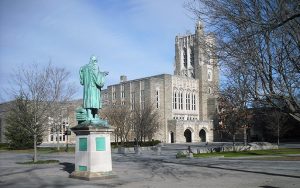
Princeton University’s Firestone Library
In 2015, members of the Princeton University Art Museum Student Advisory Board (SAB) proposed that the library created the exhibit to supplement their education into ancient and medieval history. Constantin Weickart, a member of the SAB said, “I got interested in coins through courses in Late Antiquity, and basically all my professors used coins in their lectures. I saw how important coins are not only as objects but also as historical sources. Princeton has one the best coin collections in the world.”
SAB members Weickart, Daniel Elkind, and Hannah Baumann designed the exhibit including writing the labels that were associated with the coins and other images. They worked with Dr. Alan Stahl, the University curator of numismatics.
“[The coin collection] is there primarily for educational use. A lot of classes visit the coin collection during the course of the year,” Stahl said. “Students come to do research for term papers or get images of coins to use in presentations.”
Stahl added that the exhibit is also open to outside scholars for their research, especially since the coin collection will not be part of the rotating exhibit hall but part of the permanent display.
Although the collection is maintained for research, the Princeton Library is open to the public allowing anyone to visit the exhibit. Outside researchers can contact the library to gain access to their collection and some of the collection can be viewed online.
Sample of Princeton Collection
-
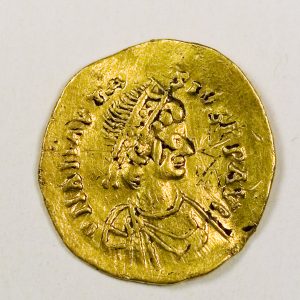
-
Byzantine Era Thrace tremissis gold coin of Anastasius I (491-518)
-

-
Carthage silver half-siliqua Justinian I (527 to 565)
-
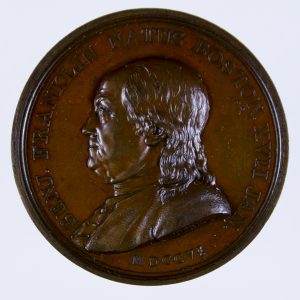
-
1786 Benjamin Franklin Medal by the Paris Mint

 → Read more at edition.cnn.com
→ Read more at edition.cnn.com
 → Read more at gainesvillecoins.com
→ Read more at gainesvillecoins.com
 → Read more at atlasobscura.com
→ Read more at atlasobscura.com
 → Read more at unian.info
→ Read more at unian.info
 → Read more at usatoday.com
→ Read more at usatoday.com

 Once again, the State Department is about to do something that negatively affects a part of numismatics. Even if you are not an ancient coin collector, the ability to collect and study ancient coins helps give all of us clarity into history.
Once again, the State Department is about to do something that negatively affects a part of numismatics. Even if you are not an ancient coin collector, the ability to collect and study ancient coins helps give all of us clarity into history.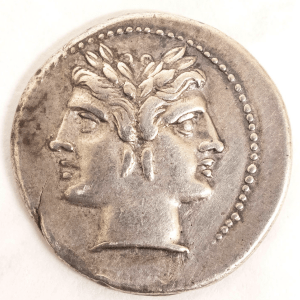





 This week, the
This week, the 








